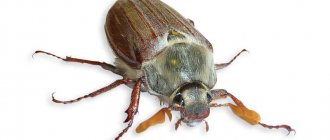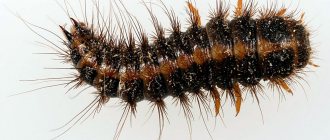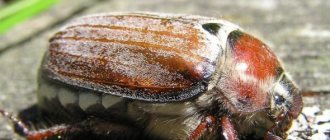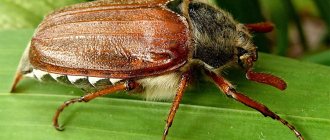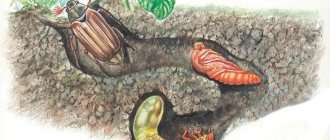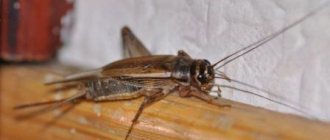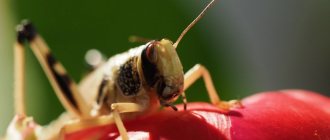Mole cricket larvae: what are their features
Mole cricket larvae begin active life with the arrival of real spring warmth. They overwinter, buried to a depth of about 2 meters or in dung heaps. The closer it gets warm, the higher the larvae rise to the surface of the earth. At a ground temperature of about +12 degrees, they already feel very comfortable.
In the month of May, the process of laying eggs begins. It is characterized by the fact that sexually mature individuals emerge from their hiding places at night to the surface of the earth and go in search of sexual partners. After mating, the female is busy making a nest for herself. At a depth of about 5 centimeters below the surface of the soil, it digs many underground passages. The main nest is located at a depth of no more than 20 cm.
The female lays at least 400 eggs, which ensures the necessary level of survival of the species. The development of eggs and the birth of mole cricket larvae occur under certain conditions. This requires high humidity, high temperature and air access.
It is important to know! The larva of the mole cricket has fundamental differences compared to the larva of the cockchafer. It is quite easy to identify pests by external signs. The larvae of this pest prefer heaps with manure, while within their nest they destroy plants that block access to sunlight to the nest. May beetle larvae prefer to be in well-groomed areas of the garden.
Effective methods of control
Only an integrated approach to exterminating the cockchafer will help completely rid the garden of pests. Follow preventive measures to help prevent pests from recurring. Useful recommendations are described at the end of the material.
Nitrogen or white clover
Many gardeners agreed that circles around trees should be sown with white clover. Why will such measures protect against cockchafers? The fact is that on the roots of white clover there live many bacteria, which, as a result of their vital activity, absorb nitrogen from the air and synthesize it into proteins. Nitrogen accumulated in the soil makes it unsightly for harmful insects.
By performing such manipulations, gardeners can not only get rid of parasites for a long time, but also improve the taste and appearance of fruits on trees. In addition, nitrogen in the soil helps slow down the growth or complete death of weeds.
DIY traps
It is possible to cope with the cockchafer population by catching adult individuals during their most active period. Considering that one female can lay up to 70 eggs, this method is popular and considered effective. To catch pests in the garden, a lot of different traps have been invented, each option has its pros and cons. Carefully study the advantages and disadvantages of each method, use the most suitable method.
Light trap:
- prepare a container (preferably shallow), lubricate it inside with any sticky substance (for example, grease);
- Place any source of bright light on the bottom;
- After sunset, place the prepared trap in an open area, near the favorite delicacies of cockchafers.
This method will help get rid of not only beetles, but also cutworms, which will protect the harvest of cabbage, beets and many other plants. For high efficiency, place such a product every evening for a week, during which time all harmful insects will be caught.
Glue trap:
hardware stores sell a variety of adhesive substances for catching flies, purchase one package of any drug; cut newspaper into medium-thick strips and soak in an adhesive solution; hang strips of newspaper throughout the garden, paying special attention to the favorite places of parasites (near potatoes, strawberries). Change strips every day, they tend to dry out
A dry strip of newspaper soaked in a special substance will not give the desired result.
Change strips every day, they tend to dry out. A dry strip of newspaper soaked in a special substance will not give the desired result.
Biological method
In nature there are a lot of animals and birds that feed on chafers. Natural pest exterminators include:
- hedgehogs They are big fans of cockchafers. To exterminate parasites, place several hedgehogs in your area, forget about the problem with pests;
- starlings. Birds love to feast on not only cockchafers; they also actively consume other harmful insects. To attract birds, build several birdhouses. Starlings fight pest larvae that cause the greatest damage to crops.
Chemicals
You shouldn't get carried away with insecticides. Excessive use of chemicals can have a detrimental effect on crops. In advanced situations they use: Bazudin, Pochin, Antikhrushch, Aktara. Each product must be used according to instructions
Follow precautionary measures, protect your respiratory tract and skin from exposure to drug particles.
Preparations against pests
Modern developments are extremely popular due to their harmlessness to humans and the absence of damage to vegetation in the garden. One of these products is Nemabact, a product classified as a bioinsecticide that can destroy harmful insects in the larval stage.
The basis for the drug is a nematode (a large microscopic worm). It is able to penetrate deep into the soil, the worm feasts on the larvae of the cockchafer, penetrating into it, leaving offspring. The parasite dies after a few days. After three days, the corpse of the cockchafer larva leaves many new nematodes, looking for other victims. The use of this product will protect the crop from pests and is absolutely safe for humans and animals.
Mole cricket larva: description of appearance
Of course, experienced gardeners can easily distinguish the larvae of these common pests of gardens and vegetable gardens, which cannot be said about novice gardeners. Mole cricket eggs, the number of which can reach 500 pieces, have a length of 1 to 3 mm, and are distinguished by a brownish-reddish tint. The development of larvae occurs over 2 weeks. If conditions are favorable enough, then less than 2 weeks is possible.
At the initial stages, the larvae resemble their family rather than caterpillars. Moreover, they are distinguished by their reddish color. In the initial stages of long-term development, they feed on the shell and saliva of their mother. After one week they molt for the first time, after which the larva increases in size. Moreover, the appearance of the larvae is completely similar to the adult individuals.
The full development cycle until the appearance of an adult takes about 2 years, and sometimes a little less. The last stage is characterized by the appearance of reproductive organs in the larva. During the entire period of development, the larva molts about 10 times, and each time it increases in size and becomes more and more similar to an adult.
It is important to know! The appearance of the larva has a certain resemblance to the adult. The development cycle does not include the caterpillar, pupa, and, especially, the butterfly stages. The development cycle is characterized by the fact that the body of the larva increases from 3 mm to 5 centimeters. Moreover, the size of adult individuals is even larger, about 12 cm.
Drugs that help fight worms
Today there are many products on sale, the use of which can significantly clear a heavily infested area of pests.
Common means of multidirectional action
Most often, summer residents use:
Procedure for using insecticides:
Biological products
In addition, there are popular biological products (“Nemabakt”, “Fitoverm”, “Boverin”, “Aktofit”), which can be used if the number of beetle larvae in the soil is not very large. Such products include natural enemies of the pest: microscopic nematode worms, pathogenic microorganisms (bacteria or fungi).
The use of biological products in recommended concentrations does not pose a danger to people, domestic animals and beneficial insects, and does not have a negative impact on the garden ecosystem as a whole.
May beetle larva
The larva of the May beetle has no external resemblance to the larva of the mole cricket, and also differs from it in stages of development.
The breeding season occurs in spring, when the birch tree begins to become covered with its first green leaves. In the month of May, with the arrival of stable warmth, the female burrows to a depth of 1 meter. After this, she lays a large number of white, almost transparent eggs.
It is important to know! The mole cricket almost never lays eggs at a significant depth, since normal development of the eggs requires warmth and access to fresh air. Therefore, a mole cricket’s nest can be found at a depth of up to 50 centimeters, digging deep into the garden.
After about 20 days, the larvae of the cockchafer are born, which are thick, white caterpillars with clearly defined rings. The larvae gradually grow and develop, increasing in size and rising closer to the surface of the earth, eating the root system of plants. The full development cycle of the larva of this insect takes several years.
Interesting fact! Mole cricket larvae begin to destroy cultivated plants almost immediately after birth, which cannot be said about the larvae of the cockchafer. The larvae of the cockchafer are not so voracious and much more harmless.
As the cockchafer larva grows, it becomes similar to a fat worm, yellowish in color. The head is brown in color and has no eyes, but the beetle has a well-developed mouthparts. The front part has three pairs of legs. Its body is translucent, so food debris can be seen in the intestines. On the sides where the rings are located, you can see brown spots. Similar features of the body structure of the cockchafer larva significantly distinguish it from the mole cricket larva.
Mole cricket larvae, May beetle larvae and bronze beetle Differences
How to get rid of white worms in indoor flowers
Houseplants are no less susceptible to insect attacks than garden plants. Improper care of flowers contributes to the appearance of flying, jumping and crawling pests. Most of them are very dangerous for plants - they damage the root system, suck juice from leaves and stems, bite through buds, preventing flowers from blooming. A common occurrence is small white worms in the soil of indoor plants.
Types of insect pests similar to worms
White or transparent worms in indoor pots are a warning sign. Pests weaken the plant and slow down its growth. The flower stops producing buds, the leaves turn yellow and wither. These worms can be either adult insects or their larvae. Whatever they are, if timely measures are not taken, the plant may die.
Insect larvae
When we talk about larvae, we usually mean several genera of insects from the order Diptera.
Mushek
Springtails (springtails, springtails) are tiny arthropods no larger than 5 mm in size. They have a jumping fork in the lower part of their body, which allows them to move quickly. Some specimens are so small that they are difficult to see. Often, owners notice white worms in the tray, in the water remaining after watering. Insects live in the soil and feed on organic debris. If this nutrition is not enough for them, the roots of the flower and young shoots are destroyed. Waterlogged soil is a favorable habitat.
Fungus gnat
Representatives of the Sciarich family that indoor gardeners encounter:
- sciara midges;
- fungus gnats;
- genus Bradysia.
Only a specialist can find the differences between these insects, but the damage they cause and the methods of control are almost the same. The insect is a small mosquito. The length of the thin body is 3-4 mm, the head is round. It has only a front pair of transparent wings, and in place of the hind wings there are club-shaped halteres.
Insects fly well and reproduce quickly. A young mosquito has a light gray body, which turns black with age. Adults do not cause any particular harm to plants, but can carry various diseases and the larvae of other pests.
The main damage is caused by fungus gnat larvae - white, transparent worms 3-5 mm long with a black head.
Insects damage the root system of indoor flowers. The supply of nutrients and moisture to the plant is disrupted, and the flower may die. The larvae get in with the contaminated soil. The second way for adults to enter an apartment is from the street through open windows. Mosquitoes prefer waterlogged soil.
Nematodes
Nematodes (roundworms) are protostomes. Zoologists suggest the existence of about a million species on earth. They live in fresh and salt water bodies, in the soil.
Nematodes are tiny worms in indoor flowers that grow in moist soil and feed on living and dead plants.
Types of plant nematodes:
- Galls that settle on the roots, their secretions contribute to the formation of thickenings in which pests live and reproduce. When the eggs mature, the shell is destroyed and the larvae spread in the soil.
- Nematodes with free formation of cysts are attached to the root.
- Free nematodes do not have a permanent place of residence, crawling and damaging various plant organs.
Signs of nematode damage:
- the appearance of yellow and subsequently brown and black spots on the foliage;
- reduction in leaf size, their deformation;
- curvature of stems, drying of apical buds;
- the formation of thickenings and swellings on the root system.
Nematodes lay oval eggs, from which white, partially transparent larvae emerge.
Enhytrea
The appearance of enchytrea in house flowers is difficult to notice; they live on the roots of plants. If measures are not taken, the root system will be covered in worms. Signs of damage are stunted growth, yellowing of leaves. Enchitraea often appear in greenhouses; they love warmth and moisture. Pests look like small, mobile white worms with pointed ends. The body of the worm is translucent, through which the digestive organs are visible. These pests are good food for aquarium fish.
Fighting methods
If there are pests in a flower pot, you need to get rid of them urgently. Depending on the degree of damage, choose control methods.
Mechanical
Since white worms live mainly in the soil, mechanical removal is ineffective. You can remove or wash off the adult specimens from the roots, but you will not be able to get rid of the eggs and larvae. If pests have just appeared, replant the indoor plant in healthy, calcined soil. Treat the soil with insecticides. When replanting, remove adult insects, larvae and eggs from the root system. Trim damaged areas and treat with disinfectant solutions.
Chemical
In a specialized store you will be offered several proven drugs for controlling soil pests:
- "Carbation" is a fumigatory agent. Used once to protect the flower and to sterilize the soil.
- “Agravertin” is a safe, highly effective product that does not cause addiction among pests, and its effectiveness increases in the hot season.
- “Fitoverm” – a few hours after treatment causes paralysis in pests, after 2-3 days they die. Apply by spraying, re-treatment is recommended.
- “Confidor” - the active substance penetrates the plant tissue, the effect lasts for a long time. The drug can only harm insects.
- "Intavir" is a nerve poison that affects most insect pests. Within half an hour the feeding process stops, and within 24 hours the pests die. Does not destroy eggs.
Chemicals are toxic; safety rules must be strictly followed.
Folk remedies
If you are not a supporter of chemical reagents, try folk remedies:
- Prepare a pale pink solution of potassium permanganate and water the indoor plant several times with this solution.
- Use a soap solution for spraying.
- Place citrus peels, garlic cloves near the flowers, and treat the soil with anise oil.
- Prepare a solution of 5 g of tobacco dust and a liter of water. After steeping for 24 hours, spray the plant and soil in the pot. Repeat the procedure once a week for 1-1.5 months.
Main differences
There are a number of differences that help determine what kind of living creature a given larva represents. For example:
- The mole cricket larva does not go through the worm and pupa stage, so it is born as a fully formed brown pest, although over time the color becomes darker. It takes about 2 years for the pest to develop. At the last stage, wings and genitals appear.
- The cockchafer larva is a white caterpillar with clearly visible rings. Gradually increasing in size, the caterpillar grows up to 6 cm in length and seems to curl into a ring. The larva has 3 pairs of legs that grow in the front of the body. The head is brown in color and has a well-developed mouthparts. The main differences need to be known, since many beetles have similar larvae, but they do not harm agricultural crops.
Important point! The larva of the cockchafer develops in the ground for 3 years, and for the first 2 years it does not pose a particular threat to plants. In the 3rd year of its development, it becomes such a voracious creature that it eats everything that comes in its way.
If there are few larvae of both the May beetle and the mole cricket, then they are not able to cause much harm to garden plantings. But if there are a lot of them, then it can turn into a real disaster.
What crops does the pest affect?
Chafer beetles are polyphagous and damage many crops. Adult insects gnaw leaves and ovaries of poplar, oak, maple, birch, aspen, alder, walnut, linden, willow, elderberry, acacia, elm, honeysuckle, alder, rowan, and rosehip .
The insect can be seen on fruit trees and shrubs: apple, plum, cherry, grapes, sea buckthorn, black currant, gooseberry . Beetles love the needles of pine, spruce, larch, and cedar . Only the ash tree is lucky; the pest avoids it.
The larvae feed on the roots of these trees, roots and root crops of vegetable crops: potatoes, onions, beets, corn, sunflowers . The larvae cause great damage to strawberry .
Preventive actions
You can protect your site from the invasion of voracious creatures in a fairly simple way, by digging deep into the site 2 times a year. Using this method, it is possible to destroy nests, as well as destroy larvae that are in the last stage of development.
Anyone who uses regular manure as fertilizer should know that it is best to apply it in the fall. Once scattered around the garden, in the spring there will be no living mole cricket eggs left, as they will die from frost. When manure is applied in the spring, a person infects his plot with his own hands.
There are other ways to protect your area from these parasites. For example, planting beds with garlic, as well as using garlic cloves when planting garden crops, can significantly reduce the scale of infection of the area. Flower beds with marigolds, chrysanthemums, calendula, etc. have the same effect.
Pest control in the garden plot should be comprehensive. Here it is very important to combine various methods of control, including the use of chemistry. Often, traditional recipes do not help to completely get rid of pests, so insecticides have to be used. Chemicals not only quickly destroy pests, but are also able to protect the area from them for a long time.
Rules for storing rotted manure
To ensure that rotted manure does not become a real danger for the site, you should use the basic rules and methods of storing it, then the damage from insect pests is minimal.
- Polyethylene bags. Usually purchased humus or chicken droppings are laid out in the fall on one pile, and in the spring it, with living larvae, both beneficial and harmful, is added when planting plants to the soil in the garden bed. Try storing manure or compost in regular sugar plastic bags. In the fall, put the purchased organic fertilizer in bags, tie them tightly and leave them on the soil in the garden until spring, spreading them out in one layer. During frosts, the substrate in the bag will freeze and the larvae will die. In the spring, you can use organic matter from the bag without fear of the larvae of harmful insects settling in.
- Construction boxes. If the manure or compost prepared in autumn and frozen in bags is not enough for planting and you have to use fresh, unfrozen manure, then first place it in construction boxes and pour it well with a concentrated solution of potassium manganese. Treatments can be repeated up to four times. High-quality disinfection with a powerful antiseptic will definitely give a positive result and there will be no larvae.
May beetle larvae are a significant danger that can befall every gardener, so you should clearly understand all the features and secrets of fighting them.
Join our Facebook group
